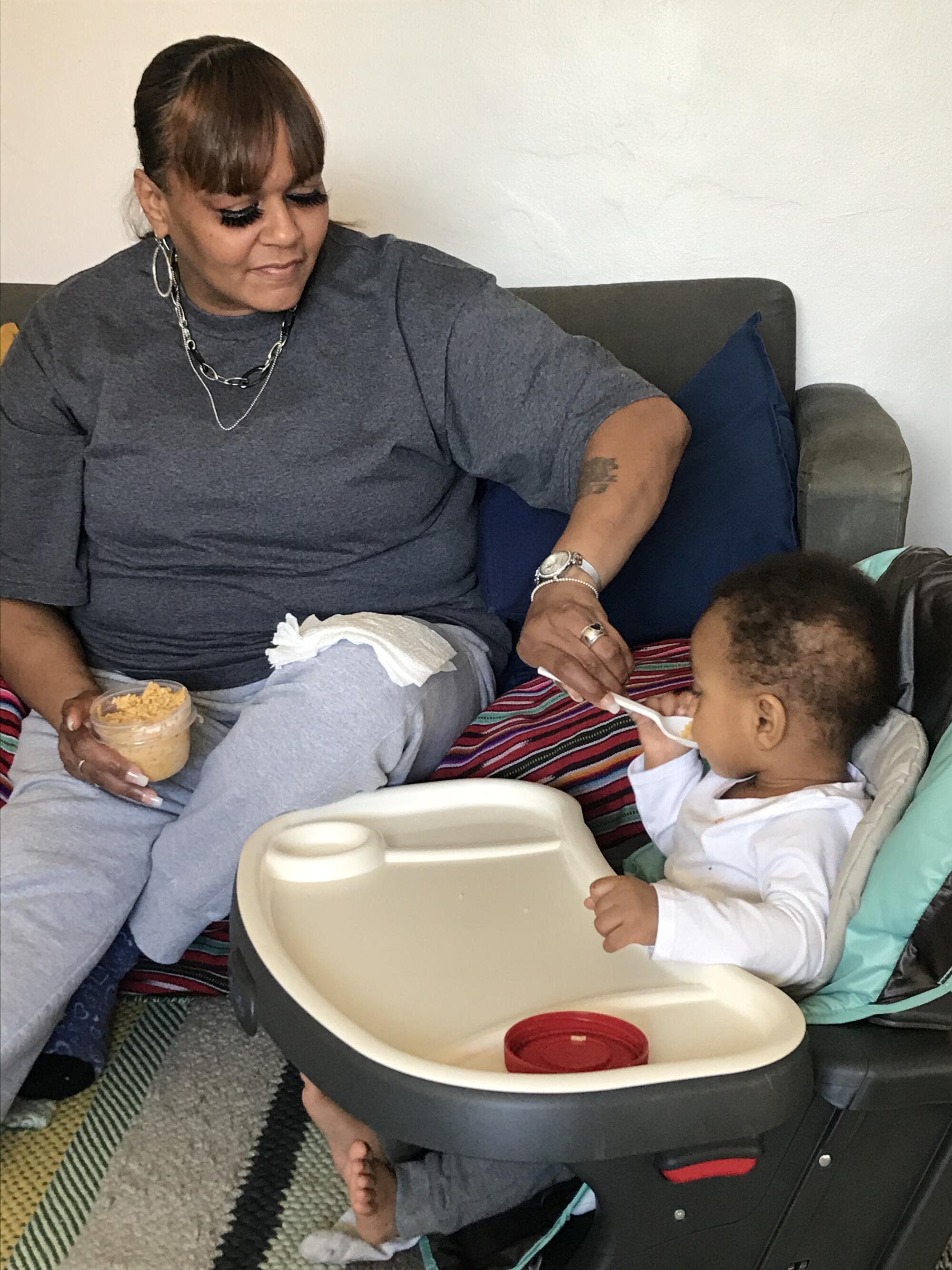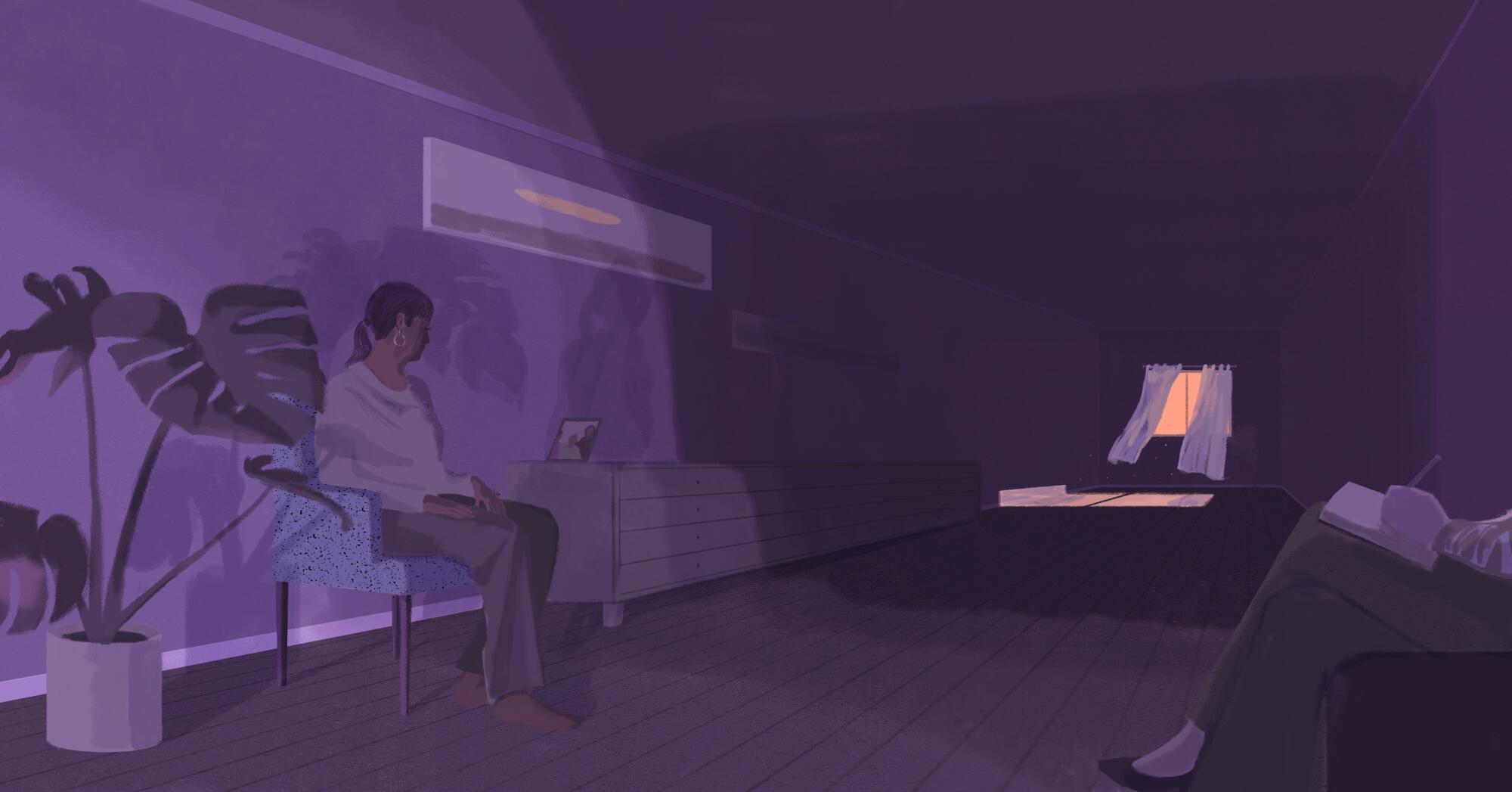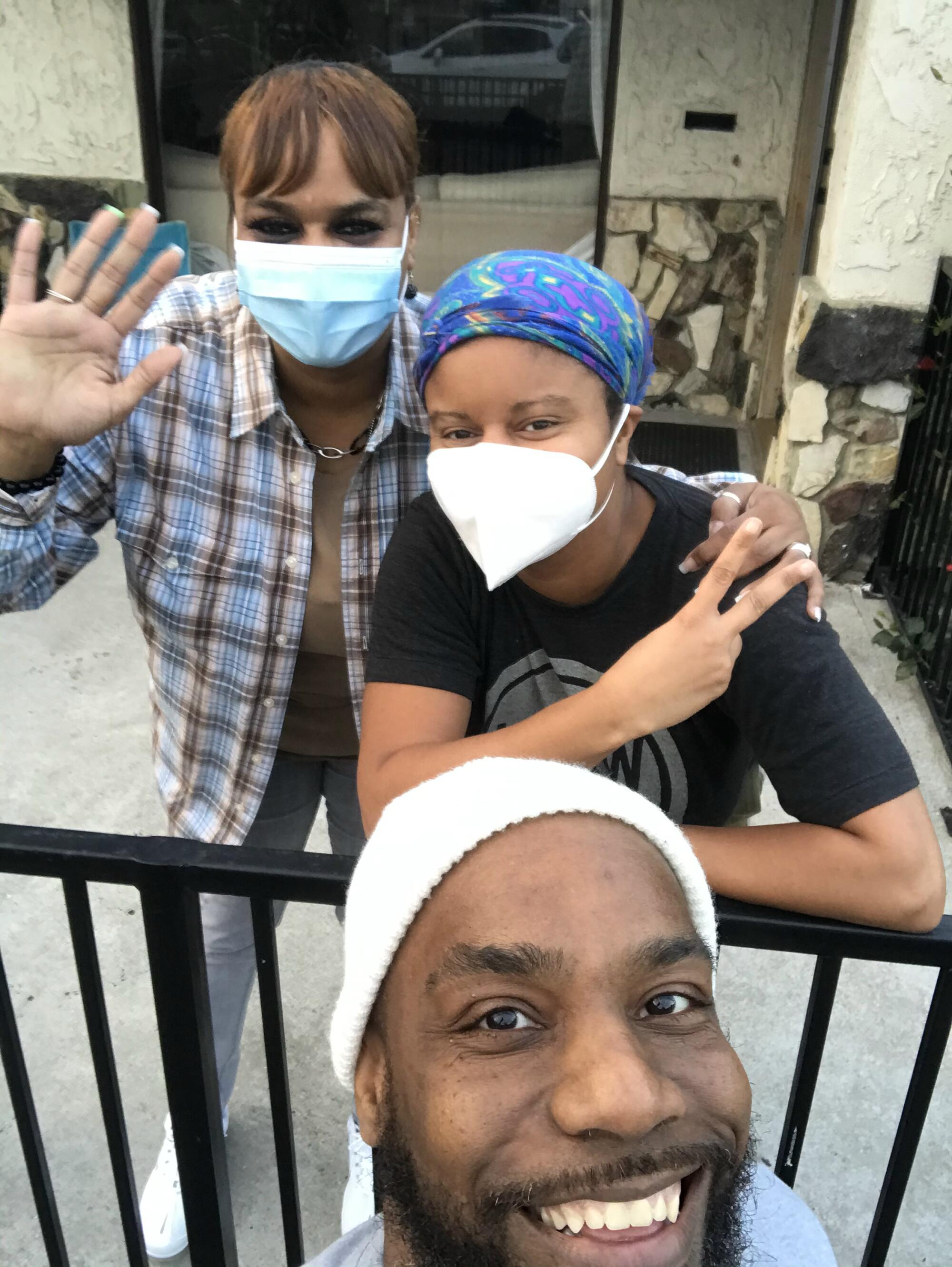Illustration by Xiao Hua Yang / For The Times
- Share via
Venus Moore had been released from the California psychiatric hospital where she was confined for years. But she was far from free.
The pandemic was raging, and her sister could provide a safe place for her to live. But Moore, 48, was required instead to live locked inside a care home for seniors. She was not allowed to drive, work, open a bank account, travel or date.
This article was published in partnership with the Marshall Project, a nonprofit news organization covering the U.S. criminal justice system. Sign up for the Marshall Project’s newsletter, or follow them on Facebook or Twitter.
The restrictions stemmed from something that had happened two decades earlier. In 2001, diagnosed with a mental illness and experiencing hallucinations, she stabbed a relative. She was charged with assault with a deadly weapon and inflicting great bodily injury. If she had been found guilty of these crimes, she could have served up to seven years in prison. Instead, she was found not guilty by reason of insanity and sent to a state hospital indefinitely.
After years of treatment, her doctors decided in 2012 that she was stable enough to return to Los Angeles. She was put on “forensic conditional release,” more commonly known as CONREP: a statewide outpatient program that primarily supervises and treats people leaving psychiatric hospitals who landed there because of serious criminal charges.

An investigation by the Marshall Project, a nonprofit journalism organization focusing on criminal justice, found that most people in the program, like Moore, were found not guilty by reason of insanity, often for violent crimes, but after years of hospitalization were ready for mental health care in the community.
CONREP, which oversees roughly 650 Californians, is meant to help patients transition from institutions to independence, while also trying to prevent violent relapses. But many patients, family members, former employees and attorneys say the system creates a legal limbo in which people can be stuck for decades, one that dictates where former patients live, whether they work and whom they see.
For those with a serious mental illness, getting out from under court control can be far more difficult than for others in the justice system. The program highlights the tension at the core of many mental health care debates today, between a concern for public safety and a patient’s rights and liberties.
“Everybody’s familiar with probation and parole,” said Jean Matulis, a lawyer who has represented people on CONREP since 1991. “This is all-inclusive, complete control of every moment of the person’s waking life.” And it can continue “forever and ever.”
In an email, the director of the Department of State Hospitals — the agency that runs CONREP — said the program’s primary goal is to prevent participants from reoffending through close monitoring as their independence is slowly increased.
“Oftentimes, this pace may feel ‘slower’ than the patient or their support system would like,” wrote Director Stephanie Clendenin. But speeding it up “to accommodate the patient’s preference would be setting them up for failure and doing them a disservice.”
According to data obtained from the Department of State Hospitals, 908 people who were found not guilty by reason of insanity were admitted to the program between January 2010 and July 2020. In that time, 289 were “restored to sanity,” meaning a court determined they were no longer dangerous and freed them from supervision.

As of last summer, people on CONREP who had been found not guilty by reason of insanity had been in the program nearly eight years on average. And, as in the criminal justice system, Black people are disproportionately represented — though just 6.5% of Californians are Black, roughly a quarter of CONREP admissions are.
That disparity is even starker in Los Angeles, where Moore lives: Nearly 40% of admissions to the program are Black, compared with just 9% of the county. Clendenin attributed this to long-standing disparities in the justice system.
Many states have some form of outpatient system for those leaving state psychiatric hospitals. California’s state hospital system is the biggest, and the vast majority of its patients (87%) end up there because of criminal charges. For them, getting out often means going through CONREP.
Only patients who respond well to treatment and make significant progress while hospitalized are considered for CONREP. Along with a court’s approval, clients have to sign a contract with a list of rules specific to them. Some patients have been banned from doing creative writing or touching another person, according to attorneys. Many are required to consult their treatment team before “major life decisions” and to introduce any new personal connections. They often have to get permission for activities ranging from joining a book club to volunteering.
“Sometimes, we would have an entire meeting to discuss whether someone could go to the store,” said Catherine Barrett, a former CONREP psychologist.
She left the Los Angeles program in 2016 over “so many issues” she had with its approach.
“They warehouse a lot of patients,” said Barrett, who said she felt pressure to keep clients on the highest levels of supervision. “Getting someone to move to a lower level of care was so exhausting…. I felt like I was just banging my head against a wall. Does their only option have to be living at a [care home] for the rest of their life?”
“Any program like this is inherently conservative,” said Grant Ute, a retired psychiatric social worker who helped develop the CONREP program. Initially, nearly a third of participants had been charged with murder or manslaughter, he said. “These were people who when it got out of control, it got way out of control. You have to be very careful.”
Being mindful of victims’ perspective is essential, said Mariam El-menshawi, director of the California Victims of Crime Resource Center. “Victims do suffer significant trauma that can last the rest of their life,” she said. They “have valid safety concerns and … the right to be heard.”
According to the Department of State Hospitals, a recent study found just 3% of surveyed people on the program were rearrested within one year of getting out of the hospital, compared with 21% of those who were released without supervision. (The study has not yet been published, and the state did not make the data on which it is based available.)
The legal system can be overly risk-averse when it comes to people with mental illness, however, said Vanderbilt University Law School professor Christopher Slobogin, who studies mental health law. “In this society, being a criminal is bad, but being ‘criminally insane’ is worse,” he said. “It is less easy to understand and therefore scarier to people. Because of the political repercussions of someone [committing more violence], the knee-jerk reaction if there’s any kind of violation is to get them back in the hospital.”
For Moore, even when her CONREP doctors found her to be stable, adjusting “better than expected” and showing “active engagement in her treatment,” she knew getting off CONREP and being fully “restored to sanity” was a difficult process. Getting a recommendation from her therapists could go a long way in swaying the court, but those were rare.

“It doesn’t matter where you’re at in your life, they still want to keep you,” Moore said. “It’s their word against yours.”
An email from the Los Angeles CONREP program, which refused to name a spokesperson, said seven people had been recommended for “restoration” in the five years since it started tracking such data. Many patients who were restored without the program’s support have had “significant issues” after getting out, the spokesperson claimed, such as stopping taking their medication, homelessness, relapse and incarceration, but the email did not provide statistics.
California’s statewide conditional release system began in 1986, in the wake of a headline-making crime. In 1978, a man convicted of sex offenses murdered a toddler weeks after getting out of a state hospital. That kind of extreme case was part of what prompted lawmakers to create more stringent, standardized supervision.
At the beginning, most CONREP services were provided by county-run mental health agencies. But in recent years, after a change in funding made it harder for counties to cover overhead costs, the program has been increasingly privatized. Now, for-profit companies run 11 of the 20 CONREP programs across California. Virginia-based corporation MHM Services took on several counties in 2014 and in 2019 signed a two-year, $17.9-million contract for the services it provides.
It’s hard to tell what effect privatization has on patients, as county-level data are often obscured due to health privacy laws. But some worry what a profit motive could mean for the quality of care.
“You have to assume [companies] want to spend less and make more,” said Donald Cohen, executive director of In the Public Interest, a think tank focused on the privatization of public services. “They have decision-making authority over the person, [and] you’re giving that control to a private operator who has other incentives.”
MHM Services did not respond to multiple requests for comment. The Department of State Hospitals said it has not seen a difference in the services provided by private and county-run programs.
Los Angeles’ CONREP is the biggest in the state and run by Gateways Hospital and Mental Health Center. According to records, the nonprofit signed a three-year, $10.3-million contract for 2018 to 2021.
Some family members and clinicians say smaller, county-run CONREPs can be more collaborative than bigger, outsourced programs. One family in Orange County, who asked to remain anonymous as their son is still under court control, said that they met with his treatment team the day he left the hospital and that after one year, he was allowed to live at home, drive a car and get a job.
“It’s not getting in the way at all — it’s a safety net,” the father said. “I can lean on CONREP. They’ll bend over backwards to make it work.”
Moore began hearing voices in the late 1990s and was prescribed medication. But when her prescription ran out, she said, her hallucinations returned. When she assaulted and stabbed her family member, Moore later told authorities, she thought she had been shot and was fighting for her life. (The victim asked not to be named and declined to comment for this story.)
Moore fled to Washington, where she landed in a psychiatric hospital on a separate assault charge. She was ultimately sent back to California, where the court found her not guilty by reason of insanity and committed her to a state hospital in 2008. She was first released to CONREP in 2012.
She was sent back to the hospital in 2015 when her treatment team alleged she had “difficulty with emotional regulation,” “increasing anxiety” over bedbugs at her residence and had violated program rules including “bullying” other participants, according to an appeals court decision in her case. Moore denies the violations and disputes the characterization of her stability. It took 3½ years for her to be released into CONREP again.
While in CONREP, Moore was placed in shared rooms in multiple board-and-care homes, privately run residences that provide meals and manage medication. Of her roughly $1,200 monthly Social Security check, she said, more than $1,000 went to paying rent.
Moore and other patients said the facilities were often in disrepair. Inspectors with the California Department of Social Services’ Community Care Licensing Division looked into multiple board-and-care facilities and found unsanitary kitchens and some broken appliances, according to their records. Moore and others also dealt with serious bedbug infestations, according to court records.
The Department of State Hospitals said staffers regularly visit patients’ residences and work with clients and board-and-care homes when an issue arises. A Gateways spokesperson said the nonprofit has an infection control department to help patients deal with bedbug outbreaks and to ensure homes are taking steps to eradicate them.
After rent, Moore was left with a roughly $30 weekly allowance to cover all other expenses. She and other participants said they wanted to obtain jobs but were told by program staff they couldn’t work. Former CONREP client Rick Balladares was an exception. He held a job bagging groceries at a supermarket throughout the pandemic but said he was one of only two people in his residence who was allowed to work. “I felt for the people who didn’t have jobs; they were in that building 24/7,” he said.
The L.A. Gateways spokesperson said that “work and school are two experiences which can create considerable stress, and has resulted in destabilizing patients more often than not.” Patients are often required to volunteer first before they are approved to get a job.
Covering expenses can be tough on benefits alone.
In 2013, one woman petitioned the court for restoration after more than a decade of supervision. One L.A. doctor said she was “within the top 10%” of CONREP patients he had evaluated; another noted the rarity of CONREP ever recommending restoration.
But her psychologist testified against her restoration in court, primarily because of a “lack of financial responsibility.” Earlier that year, the cost of the patient’s medicine had risen by $15, making it impossible to cover both her cellphone bill and prescription, though she continued to take her medication. The patient lost her bid to leave the program.
CONREP clinicians play conflicting roles, responsible for helping individuals cope with their mental illness but also for enforcing program rules. Many clients said this made it tough to trust their therapists, knowing that anything they said in sessions could be used to deny them privileges or even rehospitalize them.
“I can’t tell you how many times I have read reports where my clients are diagnosed as paranoid, and when you ask what’s the basis for that, it’s that they don’t trust their treatment team,” said Julia Freis, a California attorney who works on appeals in mental health cases. In one of her appeals, in which the client was in CONREP after multiple sex offenses, therapists hired someone to go undercover and watch him at his Alcoholics Anonymous meeting and report back when he accepted a hug. (According to the program, such “covert surveillance” is used only for clients with a record of sex offenses.)
Clinicians also struggle with this dynamic. “It totally destroys the therapeutic relationship,” said one former therapist with MHM Services, the for-profit provider. She asked to remain anonymous for fear of legal retribution. “You’re more of a cop than anything else.”
The L.A. Gateways spokesperson said this was the “hard part” of the job. “We are psychologists who went into this work to help people … not to ask them to give us their cellphone at the end of a session,” the spokesperson wrote in an email. “We are transparent with our patients about our role in their lives and always explaining to them our rationale for our decisions.”
In several counties, programs have struggled with staff turnover, according to interviews and program evaluations, which patients and clinicians say can disrupt treatment. Moore estimates she had at least 10 CONREP therapists over five years, many of whom were working their way toward becoming licensed mental health providers. A 2017 program review of Gateways Los Angeles, the most recent provided by the Department of State Hospitals, found that all seven clinicians on staff had been there just a few months and encouraged the program to increase retention.
Many clinicians leave for higher-paying jobs after they get licensed, employees said. A Gateways spokesperson said the nonprofit has asked for funding to increase clinicians’ salaries.
Faced with the onerous requirements of CONREP, some patients willingly return to the hospital. In California, patients found not guilty by reason of insanity for felony charges are given a maximum time of hospital commitment, which can be extended if a court finds them still dangerous. But years spent on CONREP don’t count toward this time. So, some patients said they preferred to count down to their maximum time of inpatient treatment in the hospital, rather than try to navigate an outpatient system with no promised end date.
Harold Turner is the executive director of the Urban Los Angeles chapter of the National Alliance on Mental Health, which supports families of color whose loved ones have mental illnesses. His daughter, who asked not to be named, had been in CONREP for four years when she managed to find a job in her field, only to be told by program staff that she could not accept it.
Her frustration prompted her to opt for returning to the hospital in 2019, figuring she would be fully free faster. As she wrote in a complaint, “I could see myself being at the mercy of their obscure decision making for the next 20 years if left up to them.” This winter, a court ruled she was “restored to sanity” and released her.
In 2020, the Department of State Hospitals released the program’s first strategic plan to “identify barriers” for people to safely return to their community after psychiatric hospitalization. It noted the need for more housing options, better communication between hospitals and CONREP, and a data system to “ensure timely release of appropriate patients to the community.”
Turner says the plan doesn’t go far enough. “They’re focusing on the state hospital part, but there are other parts that need fixing,” he said. CONREP “was frustrating for me and so many other families. This has been going on for way too long.”
For Moore, this year finally brought freedom. The judge in her case made the unusual decision to take her off CONREP before she was fully “restored to sanity.” She was allowed to move out of the nursing home and into an apartment her sister Janell set up for her — her first time living on her own in 20 years. Moore decorated the walls with paintings she did while locked down at the nursing home and photos of her kids and grandkids.
“In the mental health system, you literally don’t have an end date,” said Janell, ticking through the many funerals, birthdays and other milestones her sister had missed. “There is no counting down.”
Moore now receives therapy through a community mental health organization, and she has set up a bank account, gotten a driver’s license, enrolled in community college and started babysitting her 1-year-old grandson. “I accomplished a lot they said I could not do on my own,” she said.

In June, 13 years after being found not guilty by reason of insanity, Moore was deemed restored to sanity by a judge. She was fully free, something she might have experienced years earlier had she been found guilty and sentenced to prison.
“Her insight is incredibly well developed and in fact could not be any better,” a psychologist wrote in a court-ordered evaluation. “She is living in the community and has not just managed to get by but is actually thriving.”
Just five months earlier, Moore had been on the second-highest of five levels of supervision in CONREP.
“Now I don’t have that fear factor hanging over me,” Moore said, as her grandson batted at her cheek. “If I sleep in, it won’t be construed as, ‘Oh, she’s depressed.’ I can just breathe.”
More to Read
About this story
Sign up for Essential California
The most important California stories and recommendations in your inbox every morning.
You may occasionally receive promotional content from the Los Angeles Times.










